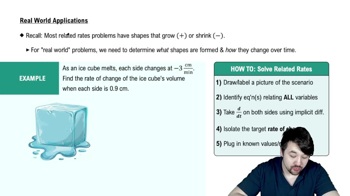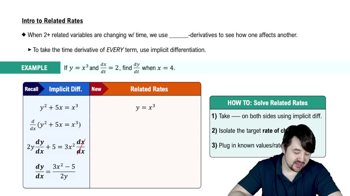Table of contents
- 0. Functions7h 52m
- Introduction to Functions16m
- Piecewise Functions10m
- Properties of Functions9m
- Common Functions1h 8m
- Transformations5m
- Combining Functions27m
- Exponent rules32m
- Exponential Functions28m
- Logarithmic Functions24m
- Properties of Logarithms34m
- Exponential & Logarithmic Equations35m
- Introduction to Trigonometric Functions38m
- Graphs of Trigonometric Functions44m
- Trigonometric Identities47m
- Inverse Trigonometric Functions48m
- 1. Limits and Continuity2h 2m
- 2. Intro to Derivatives1h 33m
- 3. Techniques of Differentiation3h 18m
- 4. Applications of Derivatives2h 38m
- 5. Graphical Applications of Derivatives6h 2m
- 6. Derivatives of Inverse, Exponential, & Logarithmic Functions2h 37m
- 7. Antiderivatives & Indefinite Integrals1h 26m
- 8. Definite Integrals3h 25m
4. Applications of Derivatives
Related Rates
Problem 3.11.33
Textbook Question
Piston compression A piston is seated at the top of a cylindrical chamber with radius 5 cm when it starts moving into the chamber at a constant speed of 3 cm/s (see figure). What is the rate of change of the volume of the cylinder when the piston is 2 cm from the base of the chamber? <IMAGE>
 Verified step by step guidance
Verified step by step guidance1
Identify the formula for the volume of a cylinder, which is given by V = πr²h, where r is the radius and h is the height of the cylinder.
Substitute the known radius of the cylinder (5 cm) into the volume formula to express the volume in terms of the height (h): V = π(5)²h = 25πh.
Determine the relationship between the height of the cylinder and the position of the piston. Since the piston is moving into the chamber, the height h can be expressed as h = H - d, where H is the total height of the chamber and d is the distance of the piston from the base.
Differentiate the volume V with respect to time t using the chain rule: dV/dt = dV/dh * dh/dt. Here, dV/dh is the derivative of the volume with respect to height, and dh/dt is the rate at which the height is changing, which is negative since the piston is moving down.
Evaluate dV/dh at the height when the piston is 2 cm from the base and multiply it by the rate of change of height (dh/dt) to find the rate of change of the volume dV/dt.
Recommended similar problem, with video answer:
 Verified Solution
Verified SolutionThis video solution was recommended by our tutors as helpful for the problem above
Video duration:
3mPlay a video:
Was this helpful?
Related Videos
Related Practice






